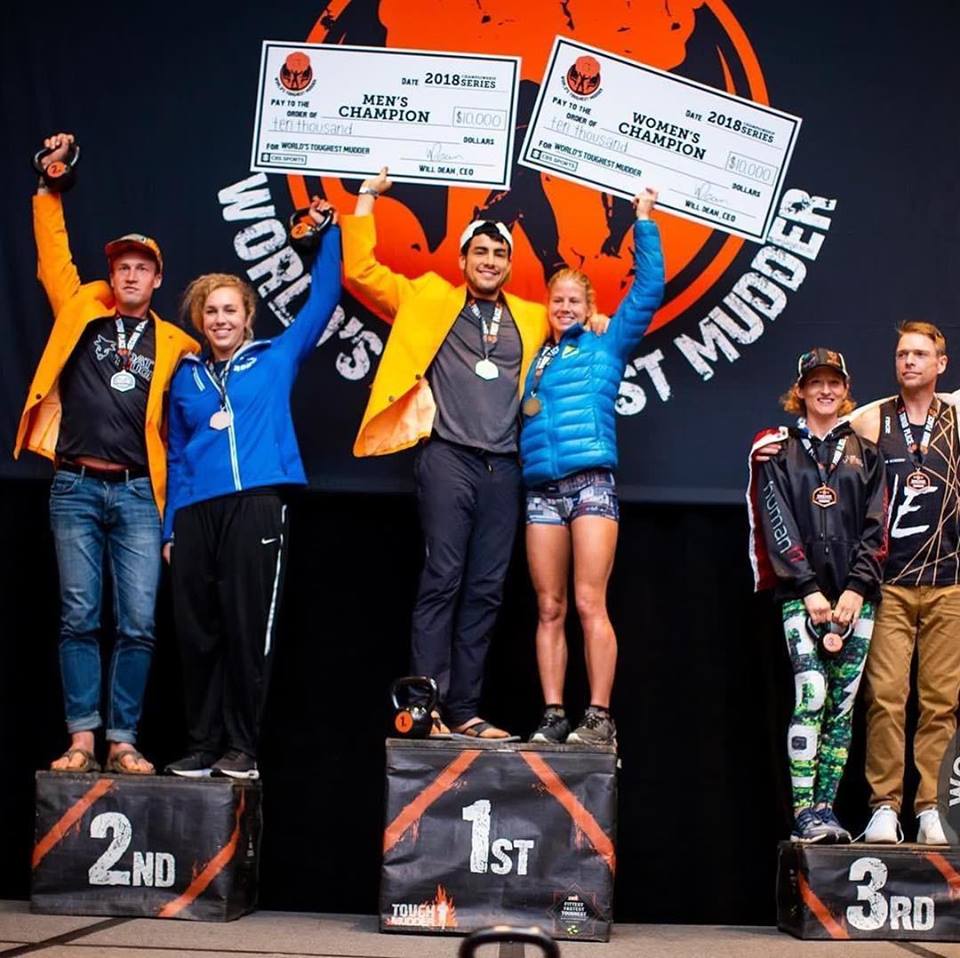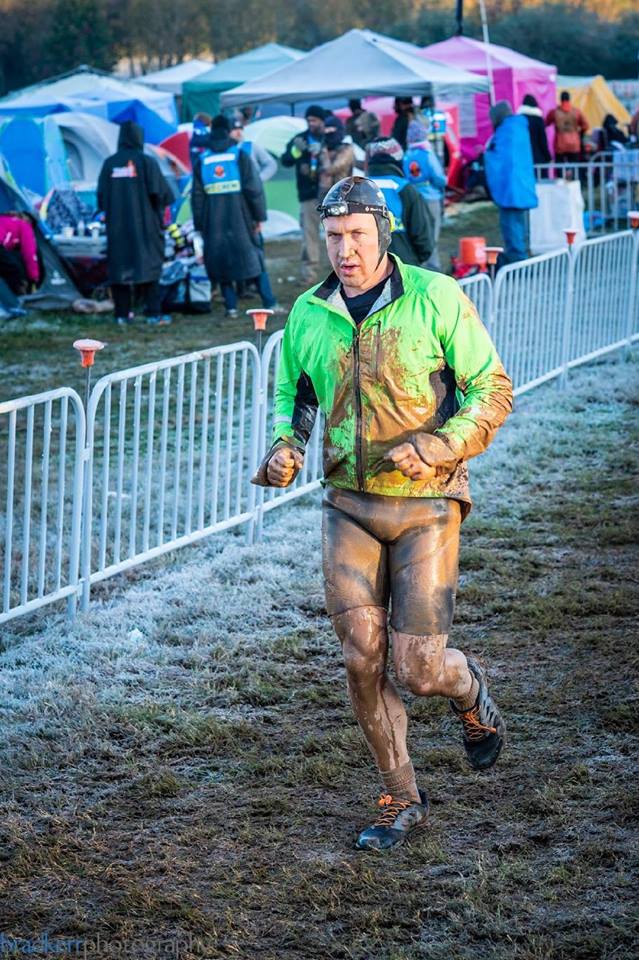If there is one thing I know about the World’s Toughest Mudder (WTM) Community, it’s they love gear. What gloves do I buy? How thick should my wet suit be? When should I put on this article of clothing? To save us all some trouble, I talked to the podium of 2018’s World’s Toughest Mudder gathering data from 1st-3rd individual males (Kris Mendoza, Trevor Cichosz, Jesse Bruce), 1st-3rd individual females (Rea Kolbl, Erin Rost and Allison Tai) and the 1st place 2+ team (Team Atomik: Evan Perperis and Wesley Kerr). Here’s what they had to say:
- Wet suit: Three of the eight athletes wore a Swim/Run wet suit by Orca that is specifically designed for designed for this type of activity. Three more athletes wore triathlon wet suits (2x Xterra and 1xNeosport). Finally, one athlete wore a Hyperflex wet suit, one designed for surfing. However, my favorite answer was from Trevor Cichosz, 2016’s WTM Champion and 5x WTM podium finisher: “I wore a wet suit, not sure of the type, some 5mm I dug out of the attic.” I’ll hit on this again at the end of the article on why this is important.Analysis: Top athletes wore everything from 2mm to 5mm in thickness of wet suits. Some layered on additional neoprene options like a vest as the event wore on and body temperatures dropped. Many opted for the swim/run type wet suits but just as many went with the triathlon wet suit. The one common theme is they were all designed for movement with various thicknesses and areas of flexibility that allow the athletes to still run and complete obstacles.
- Shoes: Somewhat surprisingly, Merrell, the shoe brand partnered with Tough Mudder had a strong representation here. While I would expect Merrell to be featured heavily in the majority of the field, the top athletes are going to choose a shoe that they feel performs best. There were three Merrell Agility Peak Flex shoes and two more Merrell All Out Crush 2’s on our list of polled athletes. With every athlete having a different foot shape there was also 2x Saloman (Speed Cross and Slab Sense Ultras) brand shoes and 1x INOV8 (Ultra 260s).Analysis: Every foot is different so it’s important to choose a shoe that fits you well and doesn’t cause blisters. The one common thread was most athletes only wore one pair or style of shoes. The only athlete to switch shoes mid-race was Rea (who went from Merrell to HOKA Stinson ATRs).
- Gloves: When a World’s Toughest Mudder champion and renowned Adventure Racer creates a pair of gloves for your sport, you better believe they are going to perform well. Out of the eight athletes, seven had BleggMits on during the race–come on Jesse Bruce, get with the program! Most wore them without anything underneath but Allison Tai went with FrogSkins gloves (fleece lined neoprene) underneath for extra warmth. Maybe I would have been able to feel my fingertips three weeks earlier if I were more like Allison.Analysis: As someone who sells BleggMits, it’s hard to say this without sounding like I’m trying to sell product. However, the athletes and the results speak for themselves. You should get a pair of BleggMits. I wonder if Allison will still need another pair of gloves underneath with the new designed BleggMit 2.0 with fleece lining (now available here).
- Type of Food/Fuel: This is the category I expected to be a little bit all over the place. Allison went with Turbo Fuel, Ramen noodles and oatmeal. Rea used Spring Energy Gels, PB & J sandwiches, energy waffles and wheat berry salad. Trevor with GU gels, Clif Shot Bloks, Uncrustables (PB & J) and pizza. Jesse and Wesley both used Tailwind with some solid food mixed in. Erin used mostly whole foods (waffles with Nutella, graham crackers with peanut butter, ramen) but still supplemented with Tailwind. Jesse also used Rise and Grind Collagen Coffee to help fuel his race. At one point Jesse said the only thing he could stomach was Krispy Kreme donuts in tea. In true Canadian fashion, One Academy’s Jesse Bruce also ate Brix Maple Syrup. Allison, where’s your Canadian pride? Personally, I went with Hammer Nutrition Perpetuem, a carb/fat/protein blend that is a liquid for most of the race before switching to PB & J sandwiches when my bottles started getting ice in them. The champion Kris Mendoza went with GU gels, GU Stroop Waffles, GU chews, RX Bars, pumpkin bread, hot chocolate and chicken broth.Analysis: Most athletes relied on some sort of nutrition specifically created for racing (Hammer Nutrition, Tailwind, Turbo, Honey Stinger, GU) which included some sort of nutrient dense liquid and then supplemented with whole foods. The most re-occurring product across all athletes was peanut butter, due to its caloric density as well as providing a mix of fat/carbs/protein in a single spoonful. The major theme is almost all athletes fueled on carbs primarily but also included fats and some protein in the mix. This lines up well with what Alex Hutchison recommends in his book “Endure” and my book “Mud Run Guide’s Ultra-OCR Bible”. Carbohydrates will be your primary source of fuel, but due to lower intensity you will also be using fat for fuel. Protein is going to help prevent muscle catabolism (using your muscles for fuel). Ensuring all three are in your system will guarantee that you have readily available access to fuel every available pathway for energy production. The wide variety in fuel types is largely determined by athlete preference and pallet.
- Any Other “Key” Pieces of Kit: The last piece of kit question I left open ended. The results were not that wide with no one citing any crazy equipment (ex. electrically heated socks, a cookie monster onesie or headphones playing Kris Mendoza’s latest rap ballad). The most common item was the neoprene hood or cap that included five athletes total including first time WTMer/2nd place woman Erin Rost. Five of the athletes also own my book, Mud Run Guide’s Ultra-Bible, although to be fair, they were all interviewed in the back of it for previous WTM performances. Three of the eight athletes said they used a windbreaker, with Rea specifically saying she wore a waterproof jacket. Finally the other common items were 2x Neptune Thermoregulation Systems (Allison and me) and Marena Sport Compressions pants/shorts (Wesley in his Red Tights and my Conquer The Gauntlet Pro Team branded shorts).Analysis: If you are going to buy one other piece of kit get a neoprene hood. From that point I would go with a windbreaker and/or a Neptune shirt. As someone who races Ultra-OCR frequently, I stand by my assessment of Marena Sport compression. Out of the 5xWTM events I have raced, only twice did I walk away with zero chaffing and both of those times I wore Marena shorts.
With all the gear choices and variables, it may seem like the options are endless. So what is the real common thread in all of these podium finishers? It’s not wet suits, gloves or hoods. It’s not the number of mm of neoprene you are wearing. It can all be boiled down to mindset. Having the “right” or better gear will make the event a little easier, but without training properly and showing up on race day with the mindset to persevere in the worst conditions, there is no amount of gear on earth that will prevent you from giving up. Trevor Cichosz’s comment on wet suits sums this up perfectly, “I wore a wet suit that I pulled out of the attic”.
Train hard, but more importantly train consistently. When you show up on race day, be prepared to suffer and you may find yourself reaching goals once thought to be impossible. If you are looking for more information on nutrition, packing lists, pacing tactics, modular training plans, in-race nutrition, and obstacle techniques specifically for Ultra-OCR then pick up a copy of the only book focused on Ultra-OCR, Mud Run Guide’s Ultra-OCR Bible.
Special thanks to Kris, Trevor, Jesse, Rea, Erin, Allison and Wesley for providing the data for this article.
Pictures provided by the athletes pictured from their public Facebook pages.






Leave A Comment